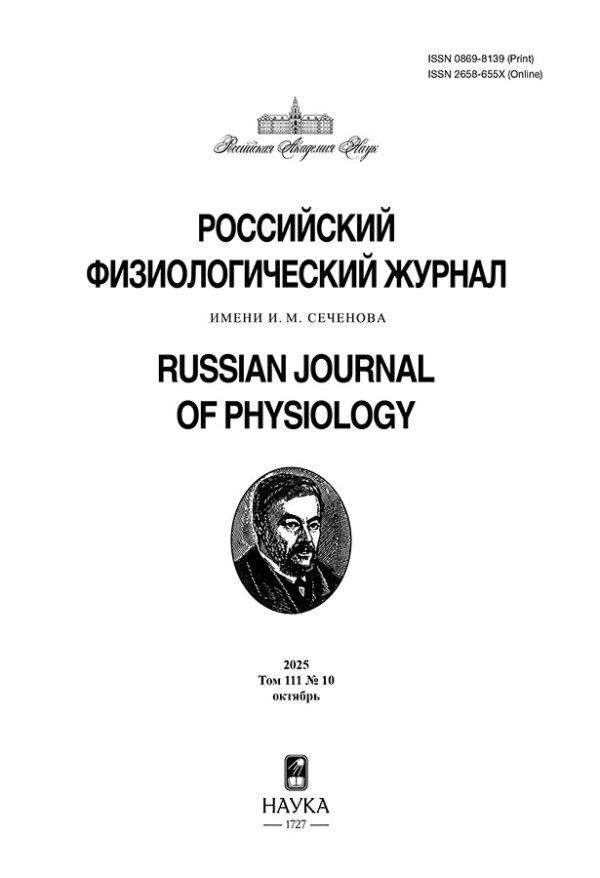Syndecan-1 as Potential Messenger of Effects of Remote Postconditioning in Experiments with Brain Ischemia
- Authors: Kolpakova M.E.1,2, Jakovleva A.A.2, Poliakova L.S.2, El Amghari H.2, Soliman S.2, Faizullina D.R.2, Sharoyko V.V.2
-
Affiliations:
- Pavlov Institute of Physiology of the Russian Academy of Science
- First Pavlov State Medical University
- Issue: Vol 110, No 3 (2024)
- Pages: 414-423
- Section: EXPERIMENTAL ARTICLES
- URL: https://modernonco.orscience.ru/0869-8139/article/view/651663
- DOI: https://doi.org/10.31857/S0869813924030068
- EDN: https://elibrary.ru/CPTAJX
- ID: 651663
Cite item
Abstract
The mechanisms of cerebral reperfusion injury restriction by remote conditionig (RC) is interesting due to its possible effects on functional recovery after brain ischemia. The assessment of the role of syndecan-1 (SDC-1) and annexin-5 (ANXA5) content in blood plasma was performed by ischemic-reperfusion injury on middle cerebral artery model in rats. We used RC protocol. Randomized controlled trials were conducted. Ischemia had been done by MCAo (middle cerebral artery occlusion) by Belayev [6]. Animals used were the Wistar rat-males weighting 250 g. under general anesthesia (Zoletil 100 и Xylazine 2%). MCAo animals had been detected 41.4*±1.3 ng/ml SDC-1 plasma’s level (30%). MCAo animals with RC protocol had been detected 67.8**±5.8 ng/ml SDC-1 plasma’s level (112%). Infarction volume in MCAo animals’ brain reviled 31.97 ± 2.5% injury; the volume of infarction was 13.6 ± 1.3%. Swelling of tissue in МCАо animals with RC was 16 ± 2.1%; in contrary, in МCАо animals’ swelling of tissue was bigger up to 47 ± 3.3%. Correlation analysis in MCAo animals with RC reviled high direct correlation relationship between infarction area and muscle strength in the right forelimb (КК=0.72). Correlation analysis reviled very high inverse correlation between infarct area and capillary blood flow in МCАо animals with RC (p < 0.01; r = -0.98). It is being discussed the SDC-1 protein in blood plasma may play role of potential regulator of infarct–limiting effects of remote ischemic postconditioning which cause functional recovery.
Full Text
About the authors
M. E. Kolpakova
Pavlov Institute of Physiology of the Russian Academy of Science;First Pavlov State Medical University
Author for correspondence.
Email: kolpakoavame@infran.ru
Russian Federation, Saint-Petersburg; Saint-Petersburg
A. A. Jakovleva
First Pavlov State Medical University
Email: kolpakoavame@infran.ru
Russian Federation, Saint-Petersburg
L. S. Poliakova
First Pavlov State Medical University
Email: kolpakoavame@infran.ru
Russian Federation, Saint-Petersburg
H. El Amghari
First Pavlov State Medical University
Email: kolpakoavame@infran.ru
Russian Federation, Saint-Petersburg
S. Soliman
First Pavlov State Medical University
Email: kolpakoavame@infran.ru
Russian Federation, Saint-Petersburg
D. R. Faizullina
First Pavlov State Medical University
Email: kolpakoavame@infran.ru
Russian Federation, Saint-Petersburg
V. V. Sharoyko
First Pavlov State Medical University
Email: kolpakoavame@infran.ru
Russian Federation, Saint-Petersburg
References
- Qi W, Zhou F, Li S, Zong Y, Zhang M, Lin Y, Zhang X, Yang H, Zou Y, Qi C, Wang T, Hu X (2016) Remote ischemic postconditioning protects ischemic brain from injury in rats with focal cerebral ischemia/reperfusion associated with suppression of TLR4 and NF-кB expression. Neuroreport 27(7): 469–475. https://doi.org/10.1097/WNR.0000000000000553
- Jain KK (2019) Introduction. The Handbook of Neuroprotection. 1–44. https://doi.org/10.1007/978-1-4939-9465-6_1
- Torres Filho I, Torres LN, Sondeen JL, Polykratis IA, Dubick MA (2013). In vivo evaluation of venular glycocalyx during hemorrhagic shock in rats using intravital microscopy. Microvascul Res 85: 128–133. https://doi.org/10.1016/j.mvr.2012.11.005
- Belayev L, Alonso R, Zhao OF, Busto W, Ginsberg MD (1996) Middle cerebral artery occlusion in the rat by intraluminal suture. Neurological and pathological evaluation of an improved model. Stroke 27: 1616–1622, discussion: 1623.
- Fluri F, Schuhmann MK, Kleinschnitz C (2015) Animal models of ischemic stroke and their application in clinical research. Drug Des Devel Ther 9: 3445–3454. https://doi.org/10.2147/DDDT.S56071
- Горшкова ОП, Шуваева ВН, Ленцман МВ, Артемьева АИ (2016) Постишемические изменения вазомоторной функции эндотелия. Совр пробл науки и образов 5: 90. [Gorshkova OP, Shuvaeva VN, Lentsman MV, Artemyeva AI (2016) Post-ischemic endothelial vasomotor function changes. Modern Probl Sci and Educat 5: 90. (In Russ)].
- Chen G, Yang J, Lu G, Guo J, Dou Y (2014) Limb remote ischemic post-conditioning reduces brain reperfusion injury by reversing eNOS uncoupling. Indian J Exp Biol 52(6): 597–605. https://doi.org/10.3390/ijms17121971
- Kirik OV, Tsyba DL, Alekseeva OS, Kolpakova ME, Jakovleva AA, Korzhevskii DE (2021) Changes in Kolmer Cells in SHR Rats after Cerebral Ischemia. Neurosci Behav Physiol 51: 1148–1152. https://doi.org/10.1007/s11055-021-01174-3
- Zhang Y, Ma L, Ren C, Liu K, Tian X, Wu D, Ding Y, Li J, Borlongan CV, Ji X (2019) Immediate Remote Ischemic Postconditioning Reduces Cerebral Damage in Ischemic Stroke Mice by Enhancing Leptomeningeal Collateral Circulation. J Cell Physiol 234: 12637–12645. https://doi.org/10.1002/jcp.27858
- Chen G, Thakkar M, Robinson C, Doré S (2018) Limb Remote Ischemic Conditioning: Mechanisms, Anesthetics, and the Potential for Expanding Therapeutic Options. Front Neurol 9: 40. https://doi.org/10.3389/fneur.2018.00040
Supplementary files













